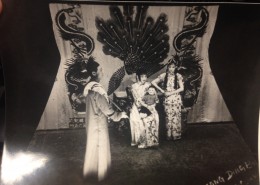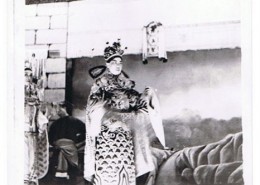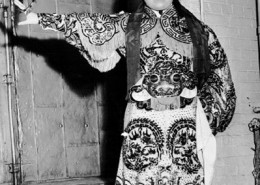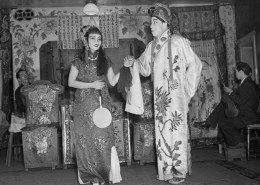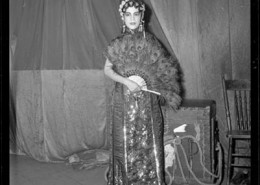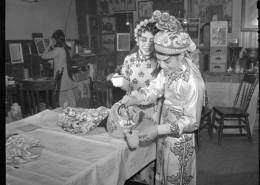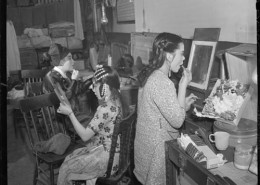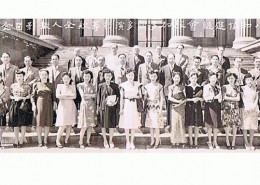Cantonese Opera in Toronto
Cantonese Opera is a traditional Chinese art whose emergence in Canadian immigrant communities brought a lot of attention to Toronto’s Chinatown. The Opera’s popularity among non-Chinese audiences reflects the shifting Canadian attitude toward the Chinese in the late 1940s. The performance of Chinese culture in Cantonese Opera created a social space in which Chinese-Canadian voices, traditions, and cultures could be presented.
THE EARLY YEARS
The origins of Cantonese Opera in Canada date back to the early 20th century. Beginning in the 1920’s in Vancouver (Johnson 5), Cantonese Opera moved eastward to Toronto and established at least 3 opera societies in Toronto’s old Chinatown neighbourhood by 1935. Two of these, The Chinese United Dramatic Society and the Ship Toy Yuen Dramatic Society, still exist today, making them Toronto’s longest standing theatre troupes (Nipp 71).
PERFORMANCE
Cantonese Opera was originally performed by only male actors who would necessarily play both male and female roles. As the opera evolved and women began performing, a complete reversal of this dynamic is reflected. Tuey Ping Lee-Hum is one example of an opera actress known for her performance of more dominant, and often military, roles (Hune).
Many opera troupes performed travelling productions which required them to limit the number of props and setts used in their performances. In order to compensate for this, Cantonese Opera utilizes the details in their costumes and gestures in order to produce meaning. “The delicate lifting of a skirt hem and tiny footsteps, for example, would indicate the crossing of a river.” (Nipp 72).
DISCRIMINATION
Cantonese Opera attracted audience members from not only the Chinese community but the larger community of Toronto as well. According to Doug Hum prominent white men were often given a special mention when they attended productions. However, despite the seemingly mainstream appeal of the opera, it was not always represented positively or accurately in mainstream media. An example of the kind of stereotypical and degrading depictions of the Chinese by the media is reflected in the newspaper article to the left.
Contribution to Chinese-Canadian Communities.
Cantonese Opera societies contributed significantly to the Chinese-Canadian community in Toronto and served a number of different purposes. Not only did they act as a vital resource for new immigrants to the country, they were also active global participants, particularly through various war relief efforts. Theatre troupes who traveled to Canada for war relief efforts also challenged the restrictions of exclusionary Canadian legislation.
COMMUNITY SIGNIFICANCE
The value of Cantonese Opera to a community whose members are discriminated against by the larger society and isolated from their homeland, families, and traditions, cannot be understated. Bernice Hune describes the importance of the Opera as a form of leisure to her mother, and others, who experienced social isolation. Many Opera societies provided welfare, housing, and employment assistance services to new immigrants (Johnson 6). Performances also provided a non-discriminatory entertainment space for Chinese-Canadians who were often turned away from movie houses during the exclusionary period (Choy).
ACTIVISM
During the Sino-Japanese Wars in the late 1930s, and the Second World War during the 1940s Cantonese Opera took on an activist role. Opera societies held fundraiser performances and other events to raise money for war relief. According to Wayson Choy, the many Chinatown’s across North America were responsible for raising more money in war bonds purchases for the war effort than any other ethnic community. The concept of uniting for a common cause and fighting for good was central to Cantonese Opera during these years. Not only was this reflected in what Choy refers to as the propaganda productions, which feature war and victory in their plots, but also in the rapid decline of Cantonese Opera during the post-war period (late 1940s-1950s).
ESCAPING EXCLUSION
Many of the fundraising events hosted by Cantonese Opera societies featured Opera troupes who traveled to Canada for war relief efforts. It was not uncommon for actresses and actors from visiting troupes to remain and settle in Canada. Both Bernice Hune and Doug Hum’s mothers were actresses who came to Canada with Opera troupes and stayed to live in the country. By offering the opportunity for the Chinese to enter Canada and avoid paying hefty head taxes, Cantonese Opera challenged the exclusionary Canadian legislation. In doing so, it reflected the important role of agency in the performance of Cantonese Opera in its Canadian context.
SOURCES
Boyd, John H. Gar Yin Hune (Nee Deer Gar Yin) and Unknown Actor Performing Cantonese Opera, Toronto. 1945. City of Toronto Archives, Toronto. Multicultural History Society of Ontario. Web. 20 Feb. 2015.
“Chinese Girls Here Aid Their Country In Fight With Japs.” Toronto Daily Star (1900-1971) 13 Sept. 1937: 2. Web. 4 Feb. 2015.
Chinese Opera. 1942. Multicultural History Society, Toronto. Multicultural History Society of Ontario. Web. 16 July 2015.
Choy, Wayson. Interview by Julie Lum. Multicultural History Society of Ontario. Multicultural History Society of Ontario, 2011. Web. 20 Feb. 2015.
Group portrait of the Jin Hong Sing Opera Troupe, Toronto. n.d. Multicultural History Society of Ontario, Toronto. Multicultural History Society of Ontario. Web. 21 Feb. 2015.
Hum, Doug. Interview by Julie Lum. Multicultural History Society of Ontario. Multicultural History Society of Ontario, 2010. Web. 20 Feb. 2015.
Hune, Bernice. Interview by Julie Lum. Multicultural History Society of Ontario. Multicultural History Society of Ontario, 2010. Web. 21 Feb. 2015.
Johnson, Elizabeth Lominska. “Cantonese Opera in its Canadian Context: The Contemporary Vitality of an Old Tradition.” Theatre Research in Canada 17.1 (1996): 1-13. Web. 8 Mar. 2015.
Milne, Gilbert A. Chinese Theatre Actress in Toronto. n.d. Archives of Ontario, Toronto. Multicultural History Society of Ontario. Web. 20 Feb. 2015.
Milne, Gilbert A. Chinese Theatre Actors in Their Dressing Room in Toronto. 1946. Archives of Ontario, Toronto. Multicultural History Society of Ontario. Web. 20 Feb. 2015.
Milne, Gilbert A. Cantonese Opera Actresses Applying Make Up for a Toronto Performance. 1946. Archives of Ontario, Toronto. Multicultural History Society of Ontario. Web. 20 Feb. 2015.
Nipp, Dora. “Toronto Chinese Drama Associations.” Polyphony 5.2 (1983): 71-73. Web. 5 Mar. 2015.
“Somewhat Like Exotic Dream is Chinese Drama as Played by Orientals on Bare Stage.” The Globe (1844-1936) 8 July 1922: 15. Web. 22 Feb. 2015.
The Jin Hong Sing Opera Troupe with Tuey Ping Lee-Hum, Toronto. n.d. Multicultural History Society of Ontario, Toronto. Multicultural History Society of Ontario. Web. 20. Feb. 2015.
Tuey Ping Lee-Hum on Stage. 1938. Multicultural History Society of Ontario, Toronto. Multicultural History Society of Ontario. Web. 20 Feb. 2015.
Tuey Ping Lee-Hum Performing in Costume. n.d. Multicultural History Society of Ontario, Toronto. Multicultural History Society of Ontario. Web. 21 Feb. 2015.

